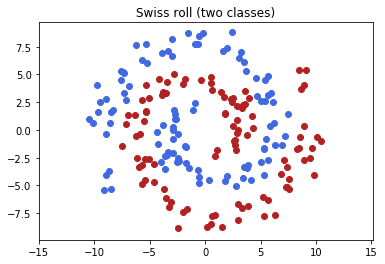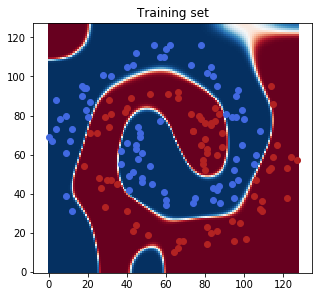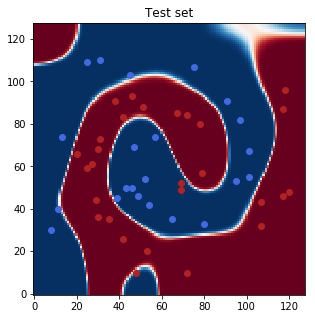Classification¶
We can model a classifier for \(C\) classes with \(N\) features using an \((N+1)\)-dimensional compressed tensor: the first \(N\) dimensions capture all possible feature values, whereas the last one has size \(C\) and is used to compute class probabilities.
Here we will try a simple \(2\)-class example in \(N = 2\), the Swiss roll classification problem.
[1]:
import tntorch as tn
import torch
import numpy as np
import matplotlib.pyplot as plt
%matplotlib inline
N = 2
C = 2 # Number of classes
P = 100 # Points per class
c0 = torch.rand(P)*8+2
c0 = c0[:, None]
c0 = torch.cat([c0*torch.cos(c0), c0*torch.sin(c0)], dim=1)
c0 += torch.randn(*c0.shape)/1.5
c1 = -c0
plt.figure()
plt.scatter(c0[:, 0], c0[:, 1], color='royalblue')
plt.scatter(c1[:, 0], c1[:, 1], color='firebrick')
plt.gca().set_aspect('equal', 'datalim')
plt.title('Swiss roll (two classes)')
plt.show()

[2]:
# Assemble (X, y) data set
X = torch.cat([c0, c1], dim=0)
y = torch.cat([torch.zeros(len(c0)), torch.ones(len(c1))])
# Shuffle data
idx = np.random.permutation(len(X))
X = X[idx]
y = y[idx]
# Discretize features into [0, 1, ..., nticks-1]
nticks = 128
X = (X-X.min()) / (X.max()-X.min())
X = X*(nticks-1)
# Split into 75% train / 25% test
ntrain = int(len(X)*0.75)
X_train = X[:ntrain, :].long()
y_train = y[:ntrain].long()
X_test = X[ntrain:, :].long()
y_test = y[ntrain:].long()
Let’s set up the \(128 \times 128 \times 2\) tensor that will be optimized. We will use an expansion using low-frequency cosine wavefunctions:
[3]:
t = tn.rand(shape=[nticks]*N + [C], ranks_tt=10, ranks_tucker=6, requires_grad=True)
t.set_factors('dct', dim=range(N))
t
[3]:
3D TT-Tucker tensor:
128 128 2
| | |
6 6 6
(0) (1) (2)
/ \ / \ / \
1 10 10 1
Our tensor’s last dimension is \(2\): for each feature \((x_1, x_2)\) it produces \(2\) numbers, one per class. For classification we will transform these weights into probabilities using the softmax function:
[4]:
def softmax(x):
expx = torch.exp(x-x.max())
return expx / torch.sum(expx, dim=-1, keepdim=True)
To assess the goodness of a matrix of probabilities (rows are instances, columns are classes) we use the cross-entropy loss:
[5]:
def cross_entropy_loss(probs, y):
return torch.mean(-torch.log(probs[np.arange(len(probs)), y]))
We are now ready to fit our tensor network:
[6]:
def loss(t):
return cross_entropy_loss(softmax(t[X_train].torch()), y_train)
tn.optimize(t, loss)
iter: 0 | loss: 0.707212 | total time: 0.0022
iter: 500 | loss: 0.056675 | total time: 1.3520
iter: 1000 | loss: 0.006464 | total time: 2.7943
iter: 1500 | loss: 0.001936 | total time: 4.1302
iter: 2000 | loss: 0.000841 | total time: 5.5035
iter: 2500 | loss: 0.000438 | total time: 6.8394
iter: 3000 | loss: 0.000254 | total time: 8.1114
iter: 3500 | loss: 0.000157 | total time: 9.4423
iter: 4000 | loss: 0.000102 | total time: 10.7657
iter: 4026 | loss: 0.000100 | total time: 10.8177 <- converged (tol=0.0001)
We now predict classes for the test instances and compute the score (#correctly classified / number of test instances):
[7]:
prediction = torch.max(t[X_test].torch(), dim=1)[1]
score = torch.sum(prediction == y_test).double() / len(y_test)
print('Score:', score)
Score: tensor(0.9400)
Finally, we will show the class probabilities for the whole feature space (blue is class 0, red is class 1):
[8]:
fig = plt.figure(figsize=(5, 5))
plt.title('Training set')
plt.imshow(softmax(t.torch())[..., 0].detach().numpy().T, origin='lower', cmap='RdBu')
plt.scatter(X_train[y_train==0, 0], X_train[y_train==0, 1], color='royalblue')
plt.scatter(X_train[y_train==1, 0], X_train[y_train==1, 1], color='firebrick')
plt.show()
fig = plt.figure(figsize=(5, 5))
plt.title('Test set')
plt.imshow(softmax(t.torch())[..., 0].detach().numpy().T, origin='lower', cmap='RdBu')
plt.scatter(X_test[y_test==0, 0], X_test[y_test==0, 1], color='royalblue')
plt.scatter(X_test[y_test==1, 0], X_test[y_test==1, 1], color='firebrick')
plt.show()

